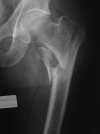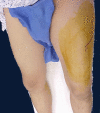Acute morbidity and complications of thigh compartment syndrome: A report of 26 cases
- PMID: 20723263
- PMCID: PMC2933643
- DOI: 10.1186/1754-9493-4-13
Acute morbidity and complications of thigh compartment syndrome: A report of 26 cases
Abstract
Background: To describe the patient population, etiology, and complications associated with thigh compartment syndrome (TCS). TCS is a rare condition, affecting less than 0.3% of trauma patients, caused by elevated pressure within a constrained fascial space which can result in tissue necrosis, fibrosis, and physical impairment in addition to other complications. Compartment releases performed after irreversible tissue ischemia has developed can lead to severe infection, amputation, and systemic complications including renal insufficiency and death.
Methods: This study examines the course of treatment of 23 consecutive patients with 26 thigh compartment syndromes sustained during an eight-year period at two Level 1 trauma centers, each admitting more than 2,000 trauma patients yearly.
Results: Patients developing TCS were young (average 35.4 years) and likely to have a vascular injury on presentation (57.7%). A tense and edematous thigh was the most consistent clinical exam finding leading to compartment release (69.5%). Average time from admission to the operating room was 18 +/- 4.3 hours and 8/23 (34.8%) were noted to have ischemic muscle changes at the time of release. Half of those patients (4/8) developed local complications requiring limb amputations.
Conclusion: TCS is often associated with high energy trauma and is difficult to diagnose in uncooperative, obtunded and multiply injured patients. Vascular injuries are a common underlying cause and require prompt recognition and a multidisciplinary approach including the trauma and orthopaedic surgeons, intensive care team, vascular surgery and interventional radiology. Prompt recognition and treatment of TCS are paramount to avoid the catastrophic acute and long term morbidities.
Figures








Similar articles
-
Thigh compartment syndrome, presentation and complications.Bosn J Basic Med Sci. 2009 Oct;9 Suppl 1(Suppl 1):S28-S33. doi: 10.17305/bjbms.2009.2751. Bosn J Basic Med Sci. 2009. PMID: 19912116 Free PMC article.
-
Thigh compartment syndrome: Outcomes in an urban level 1 trauma center.Injury. 2024 Mar;55(3):111331. doi: 10.1016/j.injury.2024.111331. Epub 2024 Jan 17. Injury. 2024. PMID: 38244251
-
Thigh compartment syndrome in urban trauma: bullets to blame, not collisions.J Surg Res. 2013 Dec;185(2):748-52. doi: 10.1016/j.jss.2013.07.003. Epub 2013 Jul 24. J Surg Res. 2013. PMID: 23932352
-
Arterial injury associated with acute compartment syndrome of the thigh following blunt trauma.Injury. 2005 Jan;36(1):151-9. doi: 10.1016/j.injury.2004.03.022. Injury. 2005. PMID: 15589934 Review.
-
Aetiology of trauma-related acute compartment syndrome of the leg: A systematic review.Injury. 2019 Jul;50 Suppl 2:S57-S64. doi: 10.1016/j.injury.2019.01.047. Epub 2019 Feb 2. Injury. 2019. PMID: 30772051
Cited by
-
Acute compartment syndrome of the contralateral thigh following reconstructive shoulder surgery done for multidirectional shoulder instability in lateral decubitus position.BMJ Case Rep. 2022 Oct 19;15(10):e252663. doi: 10.1136/bcr-2022-252663. BMJ Case Rep. 2022. PMID: 36261224 Free PMC article.
-
An updated meta analysis on traumatic causes of thigh compartment syndrome.J Clin Orthop Trauma. 2024 Nov 22;59:102840. doi: 10.1016/j.jcot.2024.102840. eCollection 2024 Dec. J Clin Orthop Trauma. 2024. PMID: 39679347 No abstract available.
-
Thigh compartment syndrome complicated by sciatic nerve palsy, rhabdomyolysis, and acute renal failure.Clin Case Rep. 2015 Nov 19;4(2):107-10. doi: 10.1002/ccr3.446. eCollection 2016 Feb. Clin Case Rep. 2015. PMID: 26862401 Free PMC article.
-
Compartment syndrome following thrombolysis: clinical features and associated conditions.J Thromb Thrombolysis. 2014;38(2):201-7. doi: 10.1007/s11239-013-1025-6. J Thromb Thrombolysis. 2014. PMID: 24272271
-
Acute compartment syndrome of the thigh in a rugby player.BMJ Case Rep. 2015 Aug 6;2015:bcr2015210856. doi: 10.1136/bcr-2015-210856. BMJ Case Rep. 2015. PMID: 26250368 Free PMC article.
References
-
- Mubarak SJ, Owen CA, Hargens AR, Garetto LP, Akeson WH. Acute compartment syndromes: diagnosis and treatment with the aid of the wick catheter. J Bone Joint Surg Am. 1978;60(8):1091–5. - PubMed
-
- Matsen FA, Winquist RA, Krugmire RB Jr. Diagnosis and management of compartmental syndromes. J Bone Joint Surg Am. 1980;62(2):286–91. - PubMed
LinkOut - more resources
Full Text Sources

